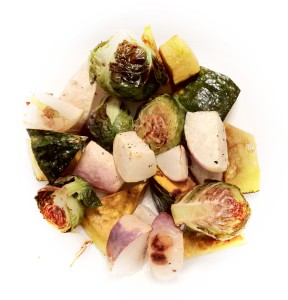By Lisa Weber, CHC, Student in the Master’s Program at Emperor’s College
What does being in balance mean to you? The right amount of career and home life? The perfect blend of work, play and sleep? An ideal day of feeling both energized and relaxed?
It might not be second nature to look to food to find balance. Yet the types of foods we eat and when we chose to eat them can make a considerable impact on our daily rhythm. Different foods have various properties – warming, cooling, energizing, grounding – and can support us in living in harmony with the seasons and with our environment.
Consider the summer season: the hot sun, low winds and high humidity. We find ourselves longing for ice cream trucks, shave ice, watermelon and iced cold lemonade. Biologically, we are craving more electrolytes and hydration to literally cool down and replenish our bodies. Nature has long produced and supplied our needs. Summer gardens produce beautiful produce from red ripe tomatoes to bright orange peaches to fresh leafy greens.
The fall the season is where we need more grounding. As we move our activities indoors, our daily pace slows down and our bodies search for warmth and comfort. We opt for soups and stews over salads and juicy fruit, and crave foods cooked with warming spices and hearty root vegetables. Our bodies are preparing for the winter cold.
Check out the recipe for roasted root vegetables at the bottom. (Pssst…makes for a great side dish to your Thanksgiving meal.)
Eating seasonal foods isn’t just a biological need. There are basic, logical reasons to adapt our diet with nature.
It’s Healthier
Fruits and vegetables grown in their natural environment at their peak growing time have more nutrients than when grown off-season. In fact, researchers in Japan found that spinach grown in the summer months has 3x more vitamin C than the plants grown in the winter months. Plus, when you focus on buying seasonal fruits and vegetables, you are buying more pure, whole foods rather than processed, packaged foods.
It’s Budget Friendly
Seasonal, local grown food has less distance to travel, requires less care to grow, and thus tend to be more affordable. Think about the price of strawberries in the middle of July versus in February when you are paying almost double the amount. Plus, those berries might have traveled hundreds of miles to get to you!
It Tastes Better!
Let’s revisit those strawberries: think about the taste of a ripe, juicy strawberry in July? Now think about the taste of a strawberry bought in February. It just isn’t the same, is it? Food grown in their natural environment has all the elements aligned. They are meant to be picked from the garden and consumed within days, not transported thousands of miles to sit in the artificial light of a grocery store. Similarly, the fall is the perfect time to enjoy pears and apples. Luckily, by eating seasonally, you can enjoy a wide variety of foods all year long.
This isn’t to say you cannot enjoy summer foods during the winter and vice versa, but take into consideration the way Mother Nature has created her bounty for us to enjoy. This fall, try to incorporate seasonal foods into your meals and start to notice how your body responds. Do you feel balanced and supported? In tune with your surroundings and environment?
Fall Foods
garlic
ginger
peppercorns
mustard seeds
sour varieties of apples, plums and grapes
cranberries, dates, figs
Root vegetables:
onions
carrots
beets
sweet potato
burdock root (gobo)
Winter squash:
acorn
butternut
spaghetti squash
kabocha
Tip: Hard to remember what fruits and veggies are in season? Check out your local farmers market!
Recipe for Roasted Root Vegetables
 1 small kabocha squash
1 small kabocha squash
1-2 turnips
2-3 cups brussels sprouts
olive oil
sea salt
black pepper
*Note: you can make this dish with a wide variety of root vegetables.
- Cube squash and turnips. The squash does require some strength so use your knife carefully.
- Once cubed, arrange vegetables on a cookie sheet.
- Drizzle olive oil on top of vegetables.
- Using your hands, rub oil onto each piece.
- Sprinkle salt and pepper to taste.
- At 400 degrees, cook for about 25-30 minutes. This will depend on your oven and how soft you like your veggies so check on them at about 20 minutes.
- Enjoy alone, over brown rice or mix in with your favorite protein source and enjoy!
Lisa Weber is a Health Coach who offers nutrition and lifestyle programs for men and women who want to lose weight, gain energy and heal recurring health issues. Graduate of the Institute for Integrative Nutrition, she is currently studying Oriental Medicine at Emperor’s College in Santa Monica, CA and loves sneaking leafy greens into any dish she can! For more information or to sign up for her newsletter, visit her website at www.HealthByLisa.com.

